The global industrial hose assembly market is projected to reach USD 41 billion by 2035, recording an absolute increase of USD 17.1 billion over the forecast period. The market is valued at USD 23.8 billion in 2025 and is set to rise at a CAGR of 5.6% during the assessment period.
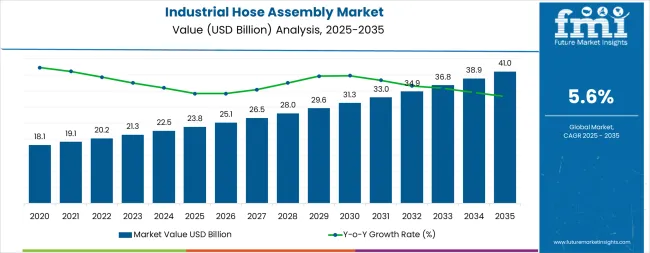
The overall market size is expected to grow by 1.7 times during the same period, supported by increasing demand for fluid transfer solutions worldwide, driving demand for advanced hose technologies and increasing investments in industrial automation and infrastructure development projects globally. Raw material price volatility and complex regulatory compliance requirements may pose challenges to market expansion.
Between 2025 and 2030, the industrial hose assembly market is projected to expand from USD 23.8 billion to USD 32.1 billion, resulting in a value increase of USD 8.3 billion, which represents 48.5% of the total forecast growth for the decade.
This phase of development will be shaped by rising demand for construction and mining applications and industrial fluid transfer systems, product innovation in pressure-resistant materials and chemical-resistant formulations, as well as expanding integration with automation systems and advanced manufacturing initiatives. Companies are establishing competitive positions through investment in advanced hose technologies, specialized component solutions, and strategic market expansion across oil & gas, chemical, and automotive applications.
From 2030 to 2035, the market is forecast to grow from USD 32.1 billion to USD 41 billion, adding another USD 8.8 billion, which constitutes 51.5% of the overall ten-year expansion. This period is expected to be characterized by the expansion of specialized hose systems, including advanced high-pressure formulations and integrated fitting solutions tailored for specific industrial requirements, strategic collaborations between hose manufacturers and end-user industries, and an enhanced focus on operational efficiency and safety compliance optimization.
The growing emphasis on industrial automation and advanced fluid handling will drive demand for advanced, high-performance industrial hose assembly solutions across diverse manufacturing and processing applications.
| Metric | Value |
|---|---|
| Market Value (2025) | USD 23.8 billion |
| Market Forecast Value (2035) | USD 41 billion |
| Forecast CAGR (2025-2035) | 5.6% |
The industrial hose assembly market grows by enabling manufacturers and facility operators to achieve superior fluid transfer efficiency and operational reliability across multiple industrial applications, ranging from small-scale processing facilities to large-scale industrial complexes. Industrial operators face mounting pressure to improve system performance and operational safety, with industrial hose assembly solutions typically providing enhanced durability and pressure resistance compared to basic piping systems, making advanced hose technology essential for demanding industrial operations.
The manufacturing and processing industry's need for maximum operational reliability creates demand for advanced hose solutions that can minimize downtime risks, enhance system flexibility, and ensure consistent performance across diverse operational environments and chemical exposures.
Government initiatives promoting industrial safety standards and environmental compliance drive adoption in construction, chemical processing, and oil & gas applications, where system reliability has a direct impact on operational safety and environmental protection. High material costs and the complexity of achieving optimal performance across different pressure and chemical requirements may limit adoption rates among cost-sensitive operators and regions with limited technical expertise.
The market is segmented by material type, product type, component type, end user, and region. By material type, the market is divided into rubber, plastics, and metal. Based on product type, the market is categorized into low pressure, medium pressure, and high pressure.
By component type, the market is classified into industrial hose assemblies and industrial hose fittings. By end user, the market is divided into food & beverages, construction & mining, chemical & pharmaceuticals, oil & gas, automotive, agriculture, general manufacturing, and others. Regionally, the market is divided into North America, Latin America, Western Europe, Eastern Europe, East Asia, South Asia Pacific, and Middle East & Africa.
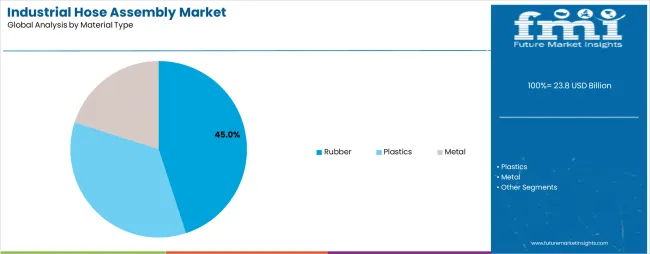
The rubber segment represents the dominant force in the industrial hose assembly market, capturing approximately 57.4% of total market share in 2025, projected to expand at a CAGR of 5.8% through 2035. This advanced material category encompasses formulations featuring superior flexibility characteristics, including enhanced abrasion resistance and temperature tolerance capabilities that enable exceptional operational performance and enhanced durability across demanding industrial conditions. The rubber segment's market leadership stems from its exceptional versatility capabilities in diverse industrial applications, with materials capable of handling various chemical exposures while maintaining consistent performance and operational reliability across challenging environmental conditions.
The plastics segment maintains substantial market presence, serving applications that require lightweight solutions and corrosion resistance for medium-pressure fluid transfer systems. These materials offer reliable performance for cost-effective applications while providing sufficient chemical resistance to meet operational requirements in food processing and agricultural applications.
Key technological advantages driving the rubber segment include:
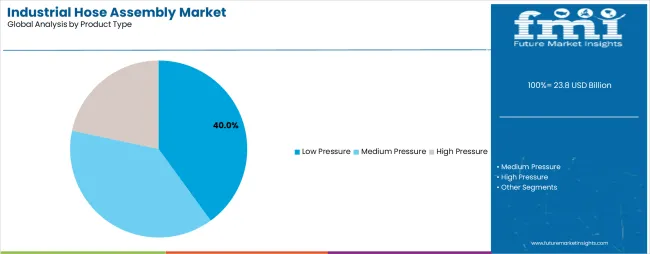
Medium pressure hoses demonstrate strong performance in the industrial hose assembly market, serving applications that require balanced performance characteristics between flexibility and pressure capability. The medium pressure segment's established position reflects the critical importance of cost-effective solutions, operational versatility, and reliable performance across food processing, agriculture, and general manufacturing applications.
High pressure hoses show significant momentum through specialized applications requiring extreme pressure resistance and enhanced durability for construction, mining, and hydraulic systems. This segment benefits from continuous advancement in reinforcement technology that provides superior strength and reliability for demanding operational applications.
Low pressure hoses maintain steady presence through applications requiring flexible, lightweight solutions for ventilation, drainage, and low-stress fluid transfer systems.
Key factors supporting product type advancement include:
Industrial hose assemblies demonstrate strong market leadership in the industrial hose assembly market, estimated at USD 15.9 billion in 2025 and projected to reach USD 27.7 billion by 2035, expanding at a CAGR of 5.7% through the forecast period. The industrial hose assemblies segment's dominant position reflects the critical importance of integrated solutions, installation efficiency, and system reliability across manufacturing, chemical processing, and construction applications.
Industrial hose fittings maintain substantial market presence through specialized connection requirements and retrofit applications that demand precision engineering and material compatibility. This segment benefits from growing maintenance and replacement needs across existing industrial facilities and equipment upgrade requirements.
Key dynamics supporting industrial hose assemblies growth include:
Construction & mining applications demonstrate the fastest growth trajectory in the industrial hose assembly market, valued at USD 5.9 billion in 2025 and forecast to reach USD 10.6 billion by 2035, growing at a CAGR of 6.1% through the forecast period. The construction & mining segment's rapid expansion reflects the critical role of infrastructure development, mining operations, and heavy equipment applications in driving hose demand across developing markets and infrastructure modernization projects.
Oil & gas applications show substantial market presence through specialized requirements for high-pressure systems, chemical-resistant materials, and extreme environment applications that create demand for advanced hose technologies. This segment benefits from continuous expansion in energy production and processing operations that require reliable fluid transfer systems.
Chemical & pharmaceuticals maintain significant market share through sanitary applications and chemical processing requirements, while food & beverages applications serve hygienic fluid transfer needs. Automotive, agriculture, and general manufacturing segments represent diverse industrial applications requiring specialized hose solutions.
Key factors supporting construction & mining growth include:
The market is driven by three concrete demand factors tied to operational efficiency and safety enhancement outcomes. First, global industrial expansion and infrastructure development create increasing demand for high-performance hose assembly solutions, with construction activities projected to exceed USD 15 trillion globally by 2030, requiring advanced fluid transfer technology for maximum operational reliability.
Second, modernization of industrial processes and automation systems drive the adoption of precision-engineered hose technologies, with facility operators seeking enhanced durability and chemical resistance to improve operational efficiency and safety compliance. Third, technological advancements in material science and manufacturing processes enable more effective and durable hose solutions that reduce maintenance complexity while improving long-term performance and operational cost-effectiveness.
Market restraints include raw material price volatility that can impact production costs and project economics, particularly during periods of commodity price fluctuations affecting rubber, steel reinforcement, and specialty chemicals used in hose manufacturing. Regulatory compliance complexity poses another significant challenge, as achieving consistent performance standards across different industrial applications and safety requirements demands specialized expertise and comprehensive testing systems, potentially causing product development delays and increased certification costs.
Technical expertise shortage in hose system design and installation creates additional challenges for end users, demanding ongoing investment in training capabilities and compliance with varying regional industrial safety standards.
Key trends indicate accelerated adoption in emerging markets, particularly China, India, and developing regions, where rapid industrialization and infrastructure development drive comprehensive hose assembly system deployment.
Technology advancement trends toward smart monitoring integration with enhanced condition monitoring, predictive maintenance capabilities, and IoT-enabled system tracking enable next-generation product development that addresses multiple operational requirements simultaneously. The market could face disruption if alternative fluid transfer technologies or significant changes in industrial processes minimize reliance on traditional hose assembly solutions.
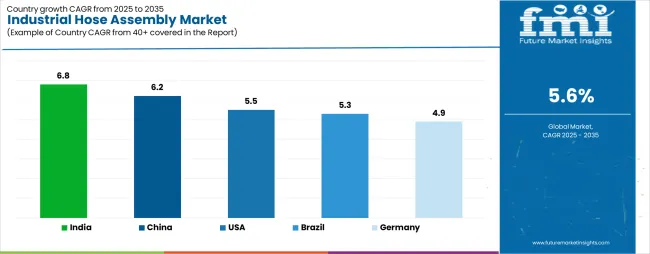
| Country | CAGR (2025-2035) |
|---|---|
| India | 6.8% |
| China | 6.2% |
| Brazil | 5.3% |
| United States | 5.5% |
| Germany | 4.9% |
The industrial hose assembly market is gaining momentum worldwide, with India taking the lead thanks to rapid industrialization and comprehensive infrastructure development initiatives. Close behind, China benefits from massive construction activity and manufacturing expansion programs, positioning itself as a strategic growth hub in the Asian region.
Brazil shows steady advancement, where mining operations and agricultural mechanization strengthen its role in the Latin American industrial development. The United States is focusing on infrastructure modernization and industrial facility upgrades, signaling an ambition to capitalize on growing opportunities in advanced hose technology markets.
Meanwhile, Germany stands out for its precision engineering and industrial automation capabilities, recording consistent progress in high-performance hose system optimization. Together, India and China anchor the global expansion story, while the rest build stability and diversity into the market's growth path.
The report covers an in-depth analysis of 40+ countries; 5 top-performing countries are highlighted below.
India demonstrates the strongest growth potential in the Industrial Hose Assembly Market with a CAGR of 6.8% through 2035. The country's leadership position stems from massive infrastructure projects, government-backed industrial development programs, and comprehensive manufacturing expansion targets, driving the adoption of high-performance industrial hose assembly systems.
Growth is concentrated in major industrial regions, including Maharashtra, Karnataka, Tamil Nadu, and Gujarat, where manufacturers and construction companies are implementing advanced hose solutions for enhanced operational performance and safety advantages.
Distribution channels through established industrial equipment suppliers and direct manufacturer relationships expand deployment across construction sites, manufacturing facilities, and mining operations. The country's Make in India strategy provides policy support for advanced industrial technology development, including high-performance hose assembly platform adoption.
Key market factors:
In Beijing, Shanghai, Guangzhou, and Shenzhen, the adoption of industrial hose assembly systems is accelerating across construction projects and manufacturing facilities, driven by industrial expansion targets and comprehensive infrastructure modernization initiatives. The market demonstrates strong growth momentum with a CAGR of 6.2% through 2035, linked to comprehensive Five-Year Plan development and increasing focus on industrial automation solutions.
Chinese manufacturers and contractors are implementing advanced hose assembly systems and specialized component platforms to enhance operational performance while meeting growing infrastructure demands in domestic and international markets. The country's industrial development programs create demand for high-performance hose solutions, while increasing emphasis on construction quality drives adoption of advanced materials and integrated assembly systems.
Brazil's advanced mining and agricultural sectors demonstrate sophisticated implementation of industrial hose assembly systems, with documented case studies showing efficiency improvements in mining applications through optimized fluid transfer solutions. The country's industrial infrastructure in major production regions, including São Paulo, Minas Gerais, Rio de Janeiro, and Paraná, showcases integration of advanced hose technologies with existing industrial systems, leveraging expertise in mining engineering and agricultural mechanization.
Brazilian operators emphasize durability and chemical resistance, creating demand for high-performance hose assembly solutions that support resource extraction and agricultural processing requirements. The market maintains steady growth through focus on industrial modernization and operational efficiency, with a CAGR of 5.3% through 2035.
Key development areas:
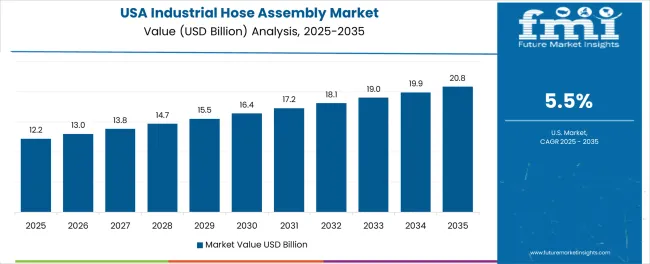
The United States' market expansion is driven by diverse industrial applications, including hose assembly deployment in Texas and California regions, manufacturing development in the Midwest, and comprehensive infrastructure modernization across multiple industrial areas. The country demonstrates promising growth potential with a CAGR of 5.5% through 2035, supported by infrastructure investment programs and regional industrial development initiatives.
American facility operators face implementation challenges related to regulatory compliance and safety standards requirements, requiring system upgrade approaches and comprehensive technical support systems. Growing operational efficiency targets and safety compliance requirements create compelling business cases for industrial hose assembly adoption, particularly in oil & gas and chemical processing sectors where system reliability has a direct impact on operational safety.
Market characteristics:
Germany's market leads in precision engineering integration based on comprehensive industrial automation and sophisticated hose assembly applications for enhanced operational characteristics. The country shows solid potential with a CAGR of 4.9% through 2035, driven by Industry 4.0 programs and manufacturing excellence initiatives across major industrial regions, including North Rhine-Westphalia, Bavaria, Baden-Württemberg, and Lower Saxony.
German manufacturers are adopting advanced hose assembly systems for process optimization and quality enhancement, particularly in regions with chemical processing and automotive manufacturing facilities requiring superior fluid transfer capabilities. Technology deployment channels through established automation companies and direct industrial relationships expand coverage across manufacturing facilities and processing plants.
Leading market segments:
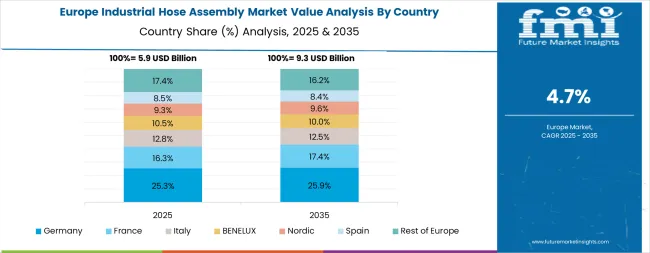
The industrial hose assembly market in Europe is projected to grow from USD 6.2 billion in 2025 to USD 10.1 billion by 2035, registering a CAGR of 5% over the forecast period. Germany is expected to maintain its leadership position with a 28.9% market share in 2025, declining slightly to 28.4% by 2035, supported by its extensive industrial infrastructure and major manufacturing centers, including North Rhine-Westphalia, Bavaria, and Baden-Württemberg technology hubs.
The United Kingdom follows with a 16.8% share in 2025, projected to reach 17.2% by 2035, driven by comprehensive industrial modernization programs and advanced process technology initiatives implementing hose assembly technologies. France holds a 15.4% share in 2025, expected to maintain 15.1% by 2035 through ongoing industrial development and manufacturing excellence programs.
Italy commands a 13.7% share, while Spain accounts for 10.3% in 2025. The Rest of Europe region is anticipated to gain momentum, expanding its collective share from 14.9% to 15.6% by 2035, attributed to increasing industrial hose assembly adoption in Nordic countries and emerging Eastern European industrial markets implementing advanced fluid transfer programs.
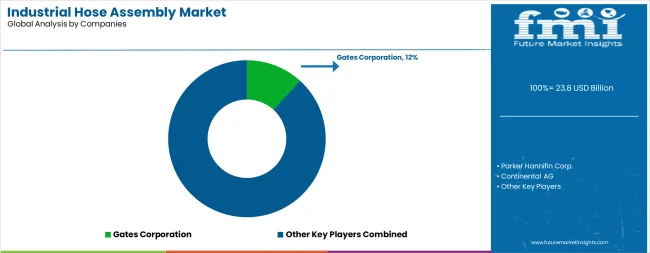
The industrial hose assembly market features approximately 20-25 meaningful players with moderate concentration, where the top five companies control roughly 45-50% of global market share through established hose technology platforms and extensive industrial relationships. Competition centers on product innovation, material expertise, and comprehensive solution capabilities rather than price competition alone.
Market leaders include Gates Corporation, Parker Hannifin Corp., and Continental AG, which maintain competitive advantages through comprehensive hose solution portfolios, global service networks, and deep expertise in the fluid transfer and industrial systems sectors, creating high switching costs for customers. These companies leverage research and development capabilities and ongoing technical support relationships to defend market positions while expanding into adjacent automation and specialized industrial applications.
Challengers encompass Eaton Corporation Plc. and Trelleborg AB, which compete through specialized hose solutions and strong regional presence in key industrial markets. Technology specialists, including Semperit AG Holding, Campbell Fittings Inc., and United Flexible, focus on specific applications or vertical markets, offering differentiated capabilities in high-pressure systems, specialty chemicals, and custom assembly solutions.
Regional players and emerging hose technology providers create competitive pressure through innovative solutions and rapid customization capabilities, particularly in high-growth markets including India, China, and developing regions, where local presence provides advantages in regulatory compliance and system integration. Market dynamics favor companies that combine advanced hose technologies with comprehensive service offerings that address the complete fluid transfer lifecycle from system design through ongoing performance optimization.
Industrial hose assemblies represent essential fluid transfer technologies that enable facility operators and industrial companies to achieve superior operational reliability and safety performance compared to conventional piping systems, delivering enhanced flexibility and durability with proven chemical resistance capabilities in demanding industrial applications.
With the market projected to grow from USD 23.8 billion in 2025 to USD 41 billion by 2035 at a 5.6% CAGR, these system solutions offer compelling advantages - enhanced operational flexibility, customizable pressure configurations, and comprehensive material compatibility - making them essential for construction facilities, chemical processing plants, and manufacturing operations seeking alternatives to rigid piping systems that compromise flexibility through installation constraints and maintenance difficulties. Scaling market adoption and technological advancement requires coordinated action across industrial safety regulations, fluid transfer standards development, hose manufacturers, industrial operators, and fluid handling investment capital.
How Governments Could Spur Local Production and Adoption?
How Industry Bodies Could Support Market Development?
How OEMs and Technology Players Could Strengthen the Ecosystem?
How Suppliers Could Navigate the Shift?
How Investors and Financial Enablers Could Unlock Value?
| Items | Values |
|---|---|
| Quantitative Units | USD 23.8 billion |
| Material Type | Rubber, Plastics, Metal |
| Product Type | Low Pressure, Medium Pressure, High Pressure |
| Component Type | Industrial Hose Assemblies, Industrial Hose Fittings |
| End User | Food & Beverages, Construction & Mining, Chemical & Pharmaceuticals, Oil & Gas, Automotive, Agriculture, General Manufacturing, Others |
| Regions Covered | North America, Latin America, Western Europe, Eastern Europe, East Asia, South Asia Pacific, Middle East & Africa |
| Country Covered | India, China, Brazil, United States, Germany, and 40+ countries |
| Key Companies Profiled | Gates Corporation, Parker Hannifin Corp., Continental AG, Eaton Corporation Plc., Trelleborg AB, Semperit AG Holding, Campbell Fittings Inc., United Flexible |
| Additional Attributes | Dollar sales by material type, product type, component type, and end user categories, regional adoption trends across East Asia, South Asia Pacific, and North America, competitive landscape with hose technology providers and industrial system integrators, operational requirements and specifications, integration with industrial automation initiatives and fluid handling systems, innovations in hose technology and assembly systems, and development of specialized configurations with durability and reliability capabilities. |
The global industrial hose assembly market is estimated to be valued at USD 23.8 billion in 2025.
The market size for the industrial hose assembly market is projected to reach USD 41.0 billion by 2035.
The industrial hose assembly market is expected to grow at a 5.6% CAGR between 2025 and 2035.
The key product types in industrial hose assembly market are rubber, plastics and metal.
In terms of product type, low pressure segment to command 40.0% share in the industrial hose assembly market in 2025.






Our Research Products

The "Full Research Suite" delivers actionable market intel, deep dives on markets or technologies, so clients act faster, cut risk, and unlock growth.

The Leaderboard benchmarks and ranks top vendors, classifying them as Established Leaders, Leading Challengers, or Disruptors & Challengers.

Locates where complements amplify value and substitutes erode it, forecasting net impact by horizon

We deliver granular, decision-grade intel: market sizing, 5-year forecasts, pricing, adoption, usage, revenue, and operational KPIs—plus competitor tracking, regulation, and value chains—across 60 countries broadly.

Spot the shifts before they hit your P&L. We track inflection points, adoption curves, pricing moves, and ecosystem plays to show where demand is heading, why it is changing, and what to do next across high-growth markets and disruptive tech

Real-time reads of user behavior. We track shifting priorities, perceptions of today’s and next-gen services, and provider experience, then pace how fast tech moves from trial to adoption, blending buyer, consumer, and channel inputs with social signals (#WhySwitch, #UX).

Partner with our analyst team to build a custom report designed around your business priorities. From analysing market trends to assessing competitors or crafting bespoke datasets, we tailor insights to your needs.
Supplier Intelligence
Discovery & Profiling
Capacity & Footprint
Performance & Risk
Compliance & Governance
Commercial Readiness
Who Supplies Whom
Scorecards & Shortlists
Playbooks & Docs
Category Intelligence
Definition & Scope
Demand & Use Cases
Cost Drivers
Market Structure
Supply Chain Map
Trade & Policy
Operating Norms
Deliverables
Buyer Intelligence
Account Basics
Spend & Scope
Procurement Model
Vendor Requirements
Terms & Policies
Entry Strategy
Pain Points & Triggers
Outputs
Pricing Analysis
Benchmarks
Trends
Should-Cost
Indexation
Landed Cost
Commercial Terms
Deliverables
Brand Analysis
Positioning & Value Prop
Share & Presence
Customer Evidence
Go-to-Market
Digital & Reputation
Compliance & Trust
KPIs & Gaps
Outputs
Full Research Suite comprises of:
Market outlook & trends analysis
Interviews & case studies
Strategic recommendations
Vendor profiles & capabilities analysis
5-year forecasts
8 regions and 60+ country-level data splits
Market segment data splits
12 months of continuous data updates
DELIVERED AS:
PDF EXCEL ONLINE
China Industrial Hoses Market - Size, Share, and Forecast 2025 to 2035
Industrial Grade Electrochemical CO Sensor Market Size and Share Forecast Outlook 2025 to 2035
Industrial Bench Scale Market Size and Share Forecast Outlook 2025 to 2035
Industrial Low Profile Floor Scale Market Size and Share Forecast Outlook 2025 to 2035
Industrial Sand Mill Market Size and Share Forecast Outlook 2025 to 2035
Industrial Control Network Modules Market Size and Share Forecast Outlook 2025 to 2035
Industrial Precision Oven Market Size and Share Forecast Outlook 2025 to 2035
Industrial Water Chiller for PCB Market Size and Share Forecast Outlook 2025 to 2035
Industrial & Commercial HVLS Fans Market Size and Share Forecast Outlook 2025 to 2035
Industrial Robot Controller Market Size and Share Forecast Outlook 2025 to 2035
Industrial Wired Routers Market Size and Share Forecast Outlook 2025 to 2035
Industrial Evaporative Condensers Market Size and Share Forecast Outlook 2025 to 2035
Industrial Energy Management System Market Size and Share Forecast Outlook 2025 to 2035
Industrial Insulation Market Size and Share Forecast Outlook 2025 to 2035
Industrial Safety Gloves Market Size and Share Forecast Outlook 2025 to 2035
Industrial Cleaner Market Size and Share Forecast Outlook 2025 to 2035
Industrial Dust Treatment System Market Size and Share Forecast Outlook 2025 to 2035
Industrial Vertical Washing Tower Market Size and Share Forecast Outlook 2025 to 2035
Industrial Pepper Market Size and Share Forecast Outlook 2025 to 2035
Industrial Electronics Packaging Market Forecast and Outlook 2025 to 2035

Thank you!
You will receive an email from our Business Development Manager. Please be sure to check your SPAM/JUNK folder too.
Chat With
MaRIA